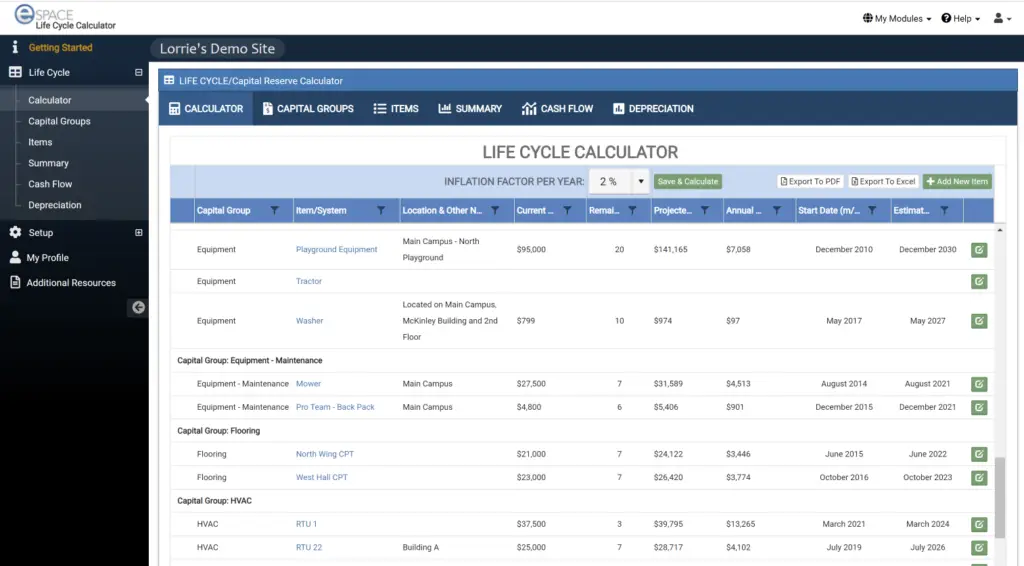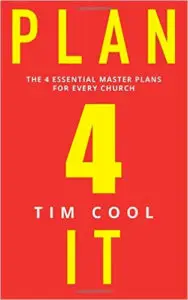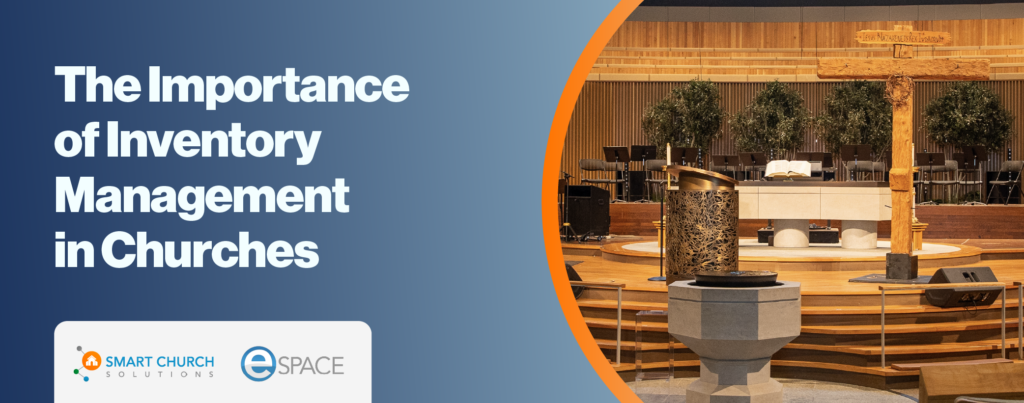In the dynamic world of facilities stewardship, effective asset management is crucial for maintaining a well-functioning and cost-efficient facility. At the heart of asset management lies the concept of asset life cycle management, a strategic approach that encompasses the entire lifespan of an asset, from its acquisition to its eventual disposal or renewal.
In this comprehensive guide, we’ll delve into the intricacies of the asset life cycle, its stages, and why it matters for churches. Additionally, we’ll explore practical implementation steps, emphasizing technology’s role, particularly within eSPACE.
What is an Asset Life Cycle?
Before we dive into the asset life cycle, it’s essential to understand what an asset is. An “asset” refers to any tangible or intangible item, equipment, or resource that holds value for an organization. Assets can include physical entities such as buildings, systems, and technology, as well as non-physical assets like software or service contracts.
Therefore, an asset life cycle is a structured framework that outlines the various stages an asset, such as the above, goes through from its acquisition to its eventual disposal or renewal. It encompasses planning, acquiring, utilizing, maintaining, and renewing or disposing of assets. Understanding the asset life cycle allows facility stewards to make informed decisions that optimize the lifespan of their assets, maximize their return on investment, and minimize downtime and maintenance costs.
What are the Stages of an Asset Life Cycle?
The asset life cycle typically comprises five key stages:
1. Plan
This initial stage involves identifying the need for an asset, defining its specifications, and determining its budget. The planning stage sets the foundation for the asset’s entire life cycle, making it a crucial step in the cycle.
2. Acquire
Once the plan is in place, assets are acquired. In the acquisition stage, the asset is procured through purchase, lease, or other means. This stage involves evaluating vendor options, negotiating contracts, and ensuring compliance with regulatory requirements. At this point, it’s also important to document the asset. In many instances, the planning and acquiring are done when a facility is initially built or prior to the current facility steward’s tenure. However, these phases are still applicable when it is renewal time.
3. Utilize
Once acquired, the asset is deployed and used to fulfill its intended purpose. This stage involves establishing usage guidelines, providing training to users, and implementing preventive maintenance procedures.
4. Maintain
Throughout its lifespan, the asset requires regular maintenance to ensure its optimal performance and longevity. This stage involves scheduling maintenance activities, tracking maintenance records, and performing repairs as needed.
5. Renew/Dispose
As the asset approaches the end of its useful life, facility stewards must decide whether to renew or dispose of it. Renewing an asset involves upgrading or refurbishing it to extend its lifespan, while disposal involves selling, scrapping, or recycling it. Life Cycle Costs are inevitable. It is not an “if” question but rather a “when” and “how much.”
Not sure when to renew or replace aging assets?
eSPACE’s Life Cycle Calculator helps you make those decisions with data, not guesswork.
Book a live demo to see how it simplifies renewals, budgeting, and timing.
Why Facility Stewards Should Care about Asset Life Cycle Management
Effective asset life cycle management offers a multitude of benefits for facility stewards, including the following:
Extended Asset Lifespan
By implementing a proactive maintenance plan and addressing issues promptly, facility stewards can extend the lifespan of their assets, reducing the need for premature replacements.
Free Up Resources
Efficient asset management frees up valuable resources that would otherwise be dedicated to dealing with asset failures and unplanned downtime. By optimizing asset performance and minimizing unexpected losses, facility stewards can free up resources that would otherwise be spent on emergency repairs, priority items, or ministry opportunities.
Decrease Downtime
Proactive maintenance and timely repairs minimize downtime, ensuring that assets are operational when needed, maximizing productivity, and minimizing revenue losses.
Improved Facility Efficiency
Effective asset management contributes to a more efficient and productive facility, ensuring that assets are used optimally and that resources are allocated effectively which can lead to a reduction in operational costs.
Proper Budgeting
Implementing a complete life cycle plan distinguishes capital reserves from operating budgets, preventing the misuse of funds and ensuring accurate budgeting for both operational and capital needs.
“If you are performing a complete life cycle plan, your capital reserves/life cycle budget differs from your operating budget. Too often, facility stewards use operational funds to replace capital assets. This inflates the actual cost of operations while deflating capital asset replacement expenditures annually. (See more about the 4 buckets of church facility budgeting.)” – Nathan Parr, Facility Stewardship Specialist
Cost Savings on Maintenance
By extending asset lifespan and preventing premature failures, facility managers can save significant costs on maintenance and repairs. The Life Cycle Calculator, in conjunction with eSPACE, is a valuable tool for budget planning in this regard. By providing comprehensive insights into maintenance schedules, anticipated costs, and strategic decision points, the Life Cycle Calculator empowers facility stewards to make informed choices, ultimately cutting back on unnecessary expenses and optimizing resource allocation.
Help with Making Decisions
Asset life cycle management provides valuable data and insights that enable facility managers to make informed decisions about asset acquisition, maintenance, and disposal.
How to Implement Asset Life Cycle Management at Your Facility
Implementing asset life cycle management at your facility involves a structured approach encompassing three vital steps.
Follow Asset Maintenance Best Practices
Establish and follow industry-standard asset maintenance practices, including regular inspections, preventive maintenance schedules, and timely repairs.
A solid maintenance routine starts with the right checklist.
This free Church Preventive Maintenance Checklist lays out essential tasks to help you stay ahead of repairs. Download it here.
Track All Assets
Implement an asset tracking system, such as eSPACE’s Life Cycle Calculator, to maintain a comprehensive inventory of all assets, including their location, condition, and maintenance history.

Utilize Software and Technology
Leverage asset management software and technology to automate tasks, track asset data, and generate reports that inform decision-making. eSPACE offers a comprehensive suite of tools to support effective asset life cycle management, allowing facility stewards to do the following:
- Track assets throughout their life cycle, from acquisition to disposal
- Schedule and manage preventive maintenance tasks
- Generate reports on asset performance and maintenance costs
- Utilize data and insights to make informed decisions about asset management
The Bottom Line on Asset Life Cycles
Here’s the bottom line: Asset life cycle management is an essential practice for facility stewards who seek to optimize asset performance, maximize resource utilization, and minimize costs. By understanding the stages of the asset life cycle and implementing effective management strategies, facility stewards can ensure that their assets contribute to their facilities’ long-term success and sustainability.
One final tidbit: As mentioned above, the eSPACE Life Cycle Calculator can help you stay on track of all of your assets. Take the first step towards smarter facility stewardship with eSPACE and ensure your assets contribute to the success of your organization. Book a demo today to learn more about how eSPACE can help you become a better facility steward.








